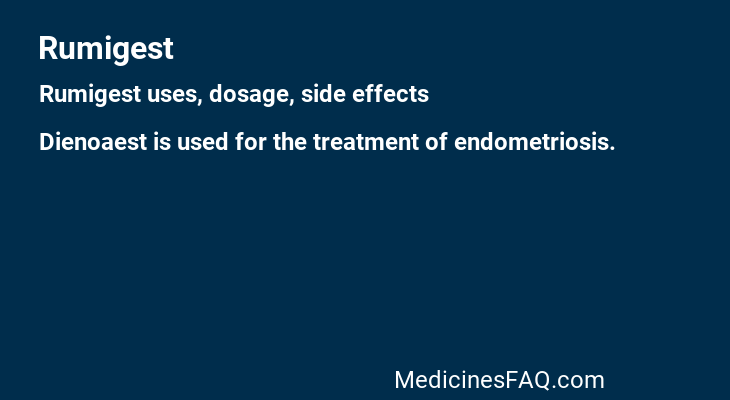Rumigest
Rumigest Uses, Dosage, Side Effects, Food Interaction and all others data.
Rumigest is a nortestosterone derivative with no androgenic but rather an antiandrogenic activity of approximately 1/3 of that of cyproterone acetate. Rumigest binds to the progesterone receptor of the human uterus with only 10% of the relative affinity of progesterone. Despite its low affinity to the progesterone receptor, dienogest has a strong progestogenic effect in vivo. Rumigest has no significant androgenic, mineralocorticoid or glucocorticoid activity in vivo.
Rumigest acts on endometriosis by reducing the endogenous production of estradiol and thereby suppressing the trophic effects of estradiol on both the eutopic and ectopic endometrium. When given continuously, dienogest leads to a hypoestrogenic, hypergestagenic endocrine environment causing initial decidualization of endometrial tissue followed by atrophy of endometriotic lesions. Additional properties eg, immunologic and antiangiogenic effects, seem to contribute to the inhibitory action of dienogest on cell proliferation.
Rumigest exhibits a very potent progestagenic effect in the endometrium, and causes endometrial atrophy after prolonged use . It also mediates an antiandrogenic effect that is equivalent to approximately one third that of cyproterone acetate . A dose of 2 mg inhibits the growth of ovarian follicles at 10 mm and maintains the concentration of progesterone at a low level, but has a weak inhibitory effect on FSH and LH. 1mg/kg of dienogest also directly inhibits ovulation . In clinical trials composing of patients with endometriosis, dienogest therapy effectively reduced painful symptoms and endometriotic lesions associated with the disorder .Rumigest displays no antiestrogenic activity as it activate neither estrogen receptor (ER) α nor ERβ [A16570], and causes hypoestrogenic effects instead as it is shown to decrease the relative expressions of ERβ and ERα . It has no glucocorticoid or mineralocorticoid effects. In combined oral contraceptive pills (COCP) with ethinyloestradiol, dienogest conjuction therapy effectively reduces the symptoms of acne and hirsutism, as well as improving excessively heavy or prolonged menstrual bleeding .
| Trade Name | Rumigest |
| Generic | Dienogest |
| Dienogest Other Names | Dienogest, Dienogestril, Dienogestum, Endometrion |
| Type | Capsule |
| Formula | C20H25NO2 |
| Weight | Average: 311.425 Monoisotopic: 311.188529049 |
| Protein binding | Dienogest is 90% nonospecifically bound to albumin. It displays no binding to sex hormone binding globulin (SHBG) or corticoid binding globulin (CBG) . |
| Groups | Approved |
| Therapeutic Class | Female Sex hormones |
| Manufacturer | Alembic Pharmaceuticals |
| Available Country | India |
| Last Updated: | September 19, 2023 at 7:00 am |

Uses
Dienoaest is used for the treatment of endometriosis.
Rumigest is also used to associated treatment for these conditions: Hypermenorrhea, Pain, Contraception, Oral Contraceptives
How Rumigest works
Rumigest acts as an agonist at the progesterone receptor (PR) with weak affinity that is comparable to that of progesterone but has a very potent progestagenic effect in the endometrium, causing endometrial atrophy after prolonged use . It promotes antiproliferative, immunologic and antiangiogenic effects on endometrial tissue. Rumigest reduces the level of endogenous production of oestradiol and thereby suppressing the trophic effects of oestradiol on both the eutopic and ectopic endometrium . Continous administration of dienogest results in hyperprogestogenic and moderately hypoestrogenic endocrine environment, which causes initial decidualization of endometrial tissue . It is an antagonist at androgen receptors, improve androgenic symptoms such as acne and hirsutism [A16570].
Dosage
Rumigest dosage
Tablet-taking can be started on any day of the menstrual cycle.
The dosage of Rumigest is 2 mg daily without any break, taken preferably at the same time each day with some liquid as needed. Tablet must be taken continuously without regard to vaginal bleeding. When a pack is finished, the next one should be started without interruption.
In the event of missed tablet(s), the woman should take 2 mg only, as soon as she remembers, and should then continue the next day to take the tablet at her usual time. A tablet not absorbed due to vomiting or diarrhea should likewise be replaced by 2 mg.
Side Effects
Increased weight; depressed mood, sleep disorder, nervousness, loss of libido, altered mood; headache, migraine; nausea, abdominal pain or distension, flatulence, vomiting; acne; alopecia; back pain; breast discomfort, ovarian cyst, hot flush, uterine/vaginal bleeding including spotting; asthenic conditions, irritability.
Toxicity
Oral LD50 in mouse is 4 mg/kg . In a long-term carcinogenicity study involving rats and mice, exposure of 10 times the dose of maximum recommended clinical dose of dienogest resulted in increased incidences of pituitary adenomas, fibroepithelial mammary tumours, stromal polyps of the uterus and malignant lymphoma . These tumors are thought to arise from marked species differences in the optimal oestrogen:progestogen ratio for reproductive function. In rat liver foci assay, dienogest did not induce tumor promotion activity . Rumigest does not display genotoxic potential.
Precaution
Before starting Rumigest treatment, pregnancy must be excluded. During treatment, patients are advised to use nonhormonal methods of contraception (e.g, barrier method) if contraception is required.
As Rumigest is a progestogen-only preparation, it can be assumed that special warnings and special precautions for use of other progestogen-only preparations are also valid for the use of Rumigest .
Changes in Bleeding Pattern: Rumigest treatment affects the menstrual bleeding pattern in the majority of women.
Hepatic Impairment: Rumigest is contraindicated in patients with present or past severe hepatic disease.
Impairment of Fertility: Based on available data, ovulation is inhibited in the majority of patients during treatment with Rumigest. However, Rumigest is not a contraceptive.
If contraception is required, a nonhormonal method should be used.
Interaction
Progestogens including Rumigest are metabolized mainly by the cytochrome P450 3A4 system . Therefore, inducers or inhibitors of CYP3A4 may affect the progestogen drug metabolism. Known CYP3A4 inhibitors like azole antifungals (e.g, ketoconazole, itraconazole, fluconazole), cimetidine, verapamil, macrolides (e.g, erythromycin, clarithromycin and roxithromycin), diltiazem, protease inhibitors (e.g, ritonavir, saquinavir, indinavir, nelfinavir), antidepressants (e.g, nefazodone, fluvoxamine, fluoxetine) may increase plasma levels of progestogens and result in adverse reactions.
Food Interaction
- Avoid grapefruit products. Grapefruit inhibits the CYP3A metabolism of dienogest, which may increase its serum concentration.
- Avoid St. John's Wort. This herb induces the CYP3A metabolism of dienogest and may reduce its serum concentration.
- Take at the same time every day.
Volume of Distribution
The apparent volume of distribution (Vd/F) of dienogest is 40 L .
Elimination Route
Rumigest is rapidly absorbed following oral administration, with 91% bioavailability. The peak plasma concentration of 47 ng/mL is reached at about 1.5 hours after single ingestion of 2 mg . The stable concentrations of the drug are reached after two days of initial treatment .
Half Life
Elimination half-life of dienogest is around 9-10 hours. The half-life of urinary metabolites excretion is 14 hours .
Clearance
The metabolic clearance rate from serum (Cl/F) is 64 mL/min .
Elimination Route
The ratio of renal elimination to fecal elimination of dienogest is 3:1, where dienogest is predominantly excreted in the form of inactive metabolites. Most of orally administered drug is excreted in the urine within the first 24 hours of ingestion .
Pregnancy & Breastfeeding use
Use in Pregnancy: There are limited data from the use of Rumigest in pregnant women. Animal studies and data from women exposed to Rumigest during pregnancy reveal no special risks on pregnancy, embryonic/fetal development, birth or development after birth for humans. However, Rumigest should not be administered to pregnant women because there is no need to treat endometriosis during pregnancy.
Use in Lactation: Treatment with Rumigest during lactation is not recommended. Physiochemical properties and animal data indicate excretion of Rumigest in breast milk. A decision must be made whether to discontinue breastfeeding or to abstain from Rumigest therapy taking into account the benefit of breastfeeding for the child and the benefit of therapy for the woman.
Contraindication
Hypersensitivity to dienogest or to any of the excipients of Rumigest. Rumigest should not be used in the presence of any of the conditions such as, Active venous thromboembolic disorder; arterial and cardiovascular disease, (e.g, myocardial infarction, cerebrovascular accident, ischemic heart disease); diabetes mellitus with vascular involvement; presence or history of severe hepatic disease as long as liver function values have not returned to normal; presence or history of liver tumors (benign or malignant); known or suspected sex hormone-dependent malignancies and undiagnosed vaginal bleeding.
Special Warning
Use in Children: Rumigest is not indicated in children prior to menarche. The safety and efficacy of Rumigest in adolescents (menarche to 18 years) has not yet been established.
Use in the Elderly: There is no relevant indication for the use of Rumigest in the geriatric population.
Acute Overdose
Acute toxicity studies performed with Rumigest did not indicate a risk of acute adverse effects in case of inadvertent intake of a multiple of the daily therapeutic dose. There is no specific antidote. Rumigest 20-30 mg/day (10-15 times higher dose than in Dinogest) over 24 weeks of use were very well tolerated.
Storage Condition
Keep in a cool and dry place. Protect from light. Keep out of the reach of children.
Innovators Monograph
You find simplified version here Rumigest
Rumigest contains Dienogest see full prescribing information from innovator Rumigest Monograph, Rumigest MSDS, Rumigest FDA label
FAQ
What is Rumigest used for?
This combination hormone medication is used to prevent pregnancy. It contains 2 hormones: dienogest (a progestin) and estradiol valerate (an estrogen). It works mainly by preventing the release of an egg (ovulation) during your menstrual cycle.
How does Rumigest help endometriosis?
Rumigest reduces the pain associated with endometriosis and is comparable to gonadotropin-releasing hormone agonists. However, some women may still need analgesia for their pelvic pain.
Does Rumigest stop my period?
This drug may stop you from having a period (menstrual bleeding) for some time. This is not a method of birth control. Use a non-hormone type of birth control like condoms to prevent pregnancy while taking this drug.
How long does Rumigest take to work?
With regard to the EAPP, Rumigest therapy was associated with a change of pain after 6 months, and an improvement rate of 84.3%. Women with higher EAPP score > 4 at baseline visit described greater improvement (92.5%) at 6-months visit, in contrast to 71.3% improvement in women with low baseline severity of EAPP ≤4
Can Rumigest increase blood pressure?
Taking this medicine can increase your risk of blood clots, stroke, or heart attack. You are even more at risk if you have high blood pressure, diabetes, high cholesterol, or if you are overweight.
Can Rumigest prevent pregnancy?
Estradiol valerate and Rumigest combination is used to prevent pregnancy. It is a birth control pill that contains two types of hormones, estrogens and progestins and, when taken properly, prevents pregnancy. It works by stopping a woman's egg from fully developing each month.
Is Rumigest a steroid?
Rumigest is a synthetic steroid that has been used as a progestogen in contraceptive pills and is currently being studied for its possible clinical use in the treatment of endometriosis.
When should I take Rumigest?
You should take this medication after food. You may start taking this medication on any day of the menstrual cycle. You should take one tablet daily without break, preferably at the same time every day, regardless of menstrual bleeding. When a pack is finished, the next pack should be started without interruption.
What are the side effects of Rumigest?
- Menstrual irregularities (if bleeding is heavy and continuous over time, it may lead to anaemia)
- Headache, Back pain.
- Breast tenderness.
- Hot flushes.
- Mood changes.
- Acne.
- Stomach discomfort (e.g. nausea, vomiting, abdominal pain)
- Weight gain.
Can Rumigest cause blood clots?
Your risk of stroke or blood clot is highest during your first year of taking Rumigest and estradiol. Your risk is also high when you restart this medicine after not taking it for 4 weeks or longer. Smoking can greatly increase your risk of blood clots, stroke, or heart attack.
Is Rumigest a birth control pill?
Rumigest is a progestin medication which is used in birth control pills and in the treatment of endometriosis. It is also used in menopausal hormone therapy and to treat heavy periods.
What is Rumigest?
Rumigest contains a hormone, the progestogen Dienogest used in the treatment of painful symptoms caused by endometriosis in women who are 18 years of age and older and have had the first menstrual cycle (menarche).
Can Rumigest cause breast pain?
The most common adverse events were irregular uterine bleeding, nausea, breast tenderness, and headache.
How long after stopping taking the pill will I get a period?
Most women will have a period around 2 to 4 weeks after stopping the pill, but this depends on you and what your cycle is normally like. Weight, health, stress, exercise and conditions such as polycystic ovary syndrome (PCOS) can all influence your cycle.
Can Rumigest cause acne?
If you develop any of these signs and symptoms you should seek medical advice immediately. Your acne will usually improve after 3 to 6 months of treatment with dienogest/ethinylestradiol.
What generation is Rumigest?
In recent years, the effectiveness of Rumigest, a fourth-generation progestin, for endometriosis treatment has been demonstrated. Rumigest seems to be as effective as gonadotrophin-releasing hormone-a (GnRH-a) in terms of endometriosis-related pelvic pain improvement.
Which birth control pill is best for acne?
The best birth control pill for acne is a combination pill—one that contains both estrogen and progestin. The FDA has approved four such birth control pills for the treatment of acne: Ortho Tri-Cyclen, Estrostep Fe, Beyaz, and Yaz.







